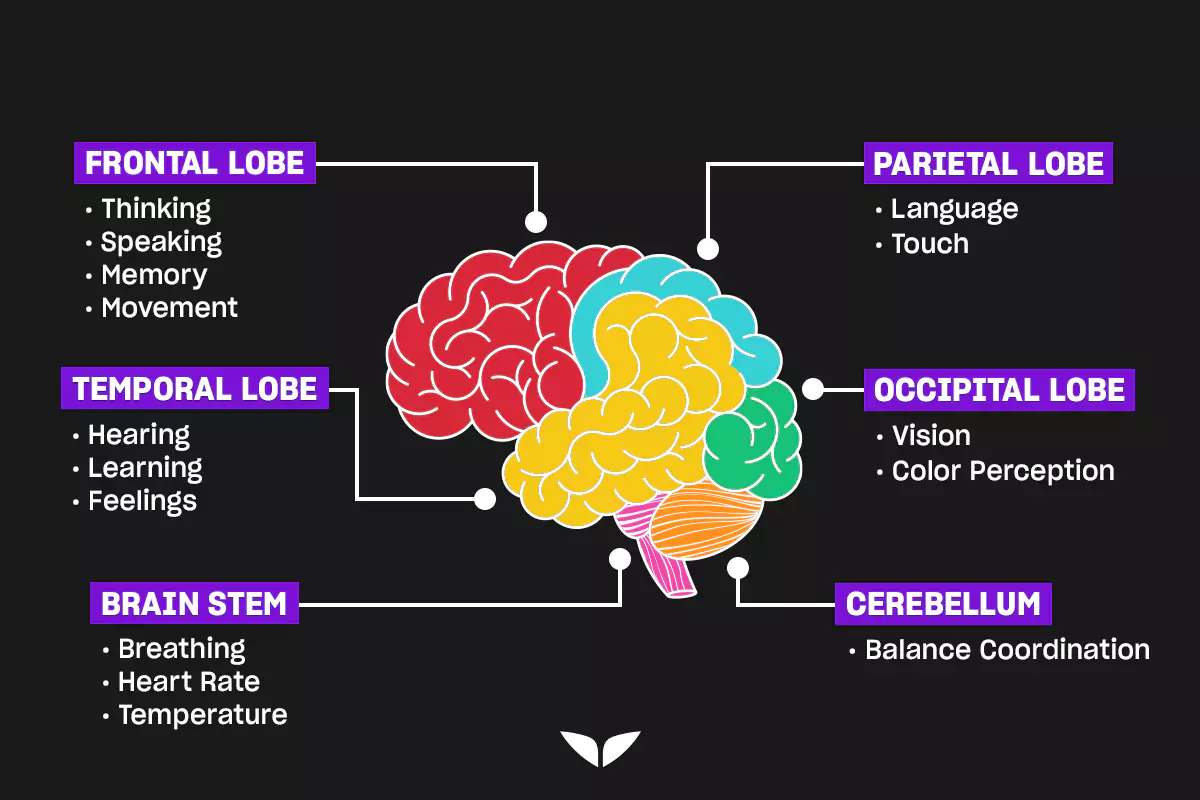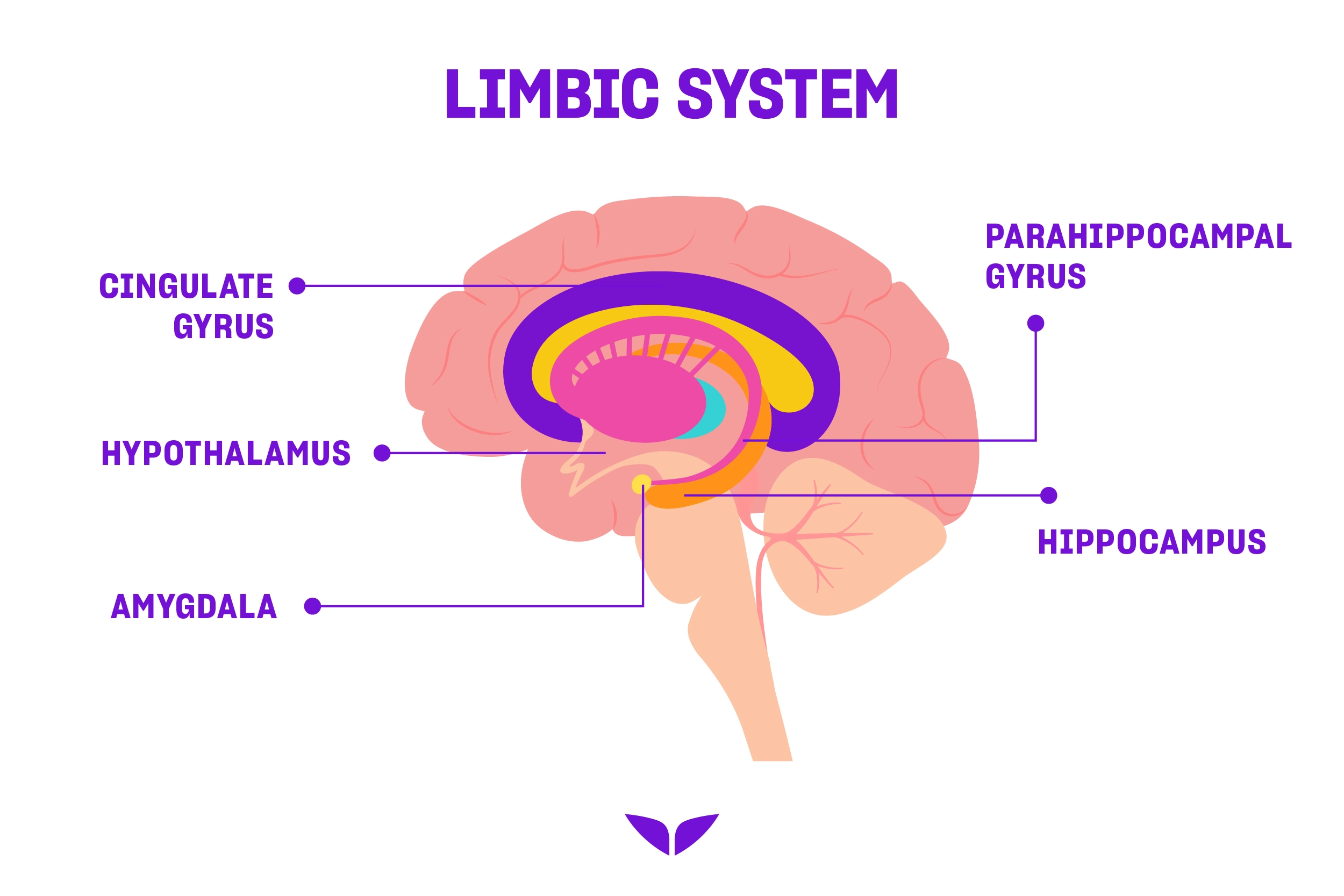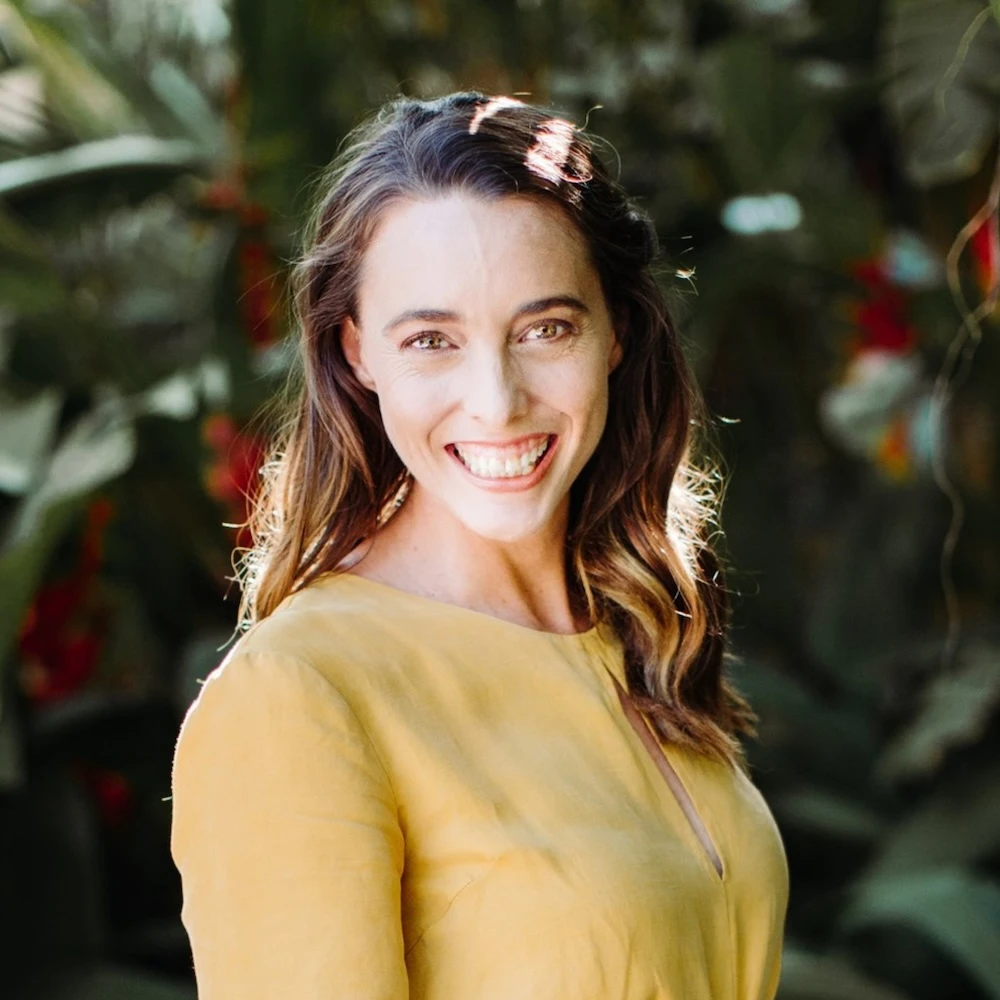Here’s food for thought: What part of the brain controls emotions?
Granted, it’s not a question that comes up in everyday conversations. And chances are, you’ve come across it in your high school biology class. So let’s dust off that memory and get curious again: what part of the brain actually controls emotions?
Because when you know where your feelings come from, you stop treating them like wild animals that need taming. Instead, you start seeing them as messengers with instructions for healing, connection, and growth.
What part of the brain controls emotions?
Your brain has an entire network dedicated to how you feel. It’s called the limbic system, and it’s where instinct meets memory, thought, and sensation. This is the part of your brain that decides whether you laugh, cry, freeze, or reach out for a hug.
Inside it are four key players:
- The hypothalamus,
- Hippocampus,
- Amygdala, and
- Limbic cortex.
The hypothalamus sets off the physical cues, like a racing heartbeat, sweaty palms, and that flutter in your stomach. The hippocampus ties those sensations to memory. The amygdala reacts fast to danger or excitement. The limbic cortex adds meaning, helping you judge, relate, and choose how to respond.
All of this happens in seconds. A thought, a scent, or a sound can awaken these particular brain regions, which translates it into feeling before you can explain it.
True, it can seem overwhelming at times. Ethan Kross, Ph.D., a psychologist who specializes in emotion regulation, points out that “so often in our lives we don’t experience our emotions proportionally; we experience them too intensely, or they last too long.”
That’s the challenge and the opportunity. Once you understand where emotions begin, you can start working with your brain instead of being swept away by it.
Where different emotions come from
In his book, Shift, Dr. Kross explains that emotions are “responses to experiences you have in the world.” Each one starts somewhere real.
Here’s how the eight from the primary emotions list connect to the parts of your brain that drive what you feel, how you act, and how you adapt.
| Emotion | Primary brain region | Function |
| Joy | Prefrontal cortex and nucleus accumbens | Creates feelings of happiness, satisfaction, and reward. |
| Trust | Prefrontal cortex and limbic cortex | Builds safety, bonding, and connection with others. |
| Fear | Amygdala | Detects danger and prepares your body to stay safe. |
| Surprise | Amygdala and prefrontal cortex | Reacts to something unexpected and refocuses your attention. |
| Sadness | Hippocampus and limbic cortex | Links loss with memory and helps you process what happened. |
| Disgust | Insular cortex | Identifies unpleasant sensations and keeps you away from harm. |
| Anger | Amygdala and hypothalamus | Raises energy and readies you to protect boundaries or take action. |
| Anticipation | Prefrontal cortex and ventral tegmental area | Fuels curiosity, planning, and motivation for what comes next. |
Every experience, including what you’re having now, which is learning about this, is an experience that your mind actually filters into your brain, and your brain responds.
— Dr. Caroline Leaf, trainer of Calm Mind: A Scientific Method for Managing Anxiety and Depression

The anatomy of feelings: How emotions form in the brain
Emotions begin as a conversation between your mind, brain, and body. The mind interprets what is happening around you, the brain responds with electrical and chemical activity, and the body mirrors that response through changes in heart rate, breathing, and muscle tone. Together, they create the experience you recognize as emotion.
“At the simplest level, something in the world stimulates our eyes, ears, skin, tongue, or nose, and that information gets turned into electrical impulses that travel through our brain,” Dr. Kross says. “Once these impulses hit the sensory cortex, the brain makes meaning out of the information it has received.”
Dr. Caroline Leaf, a neuroscientist and author of the bestselling Cleaning Up Your Mental Mess, shares a related view. In her Calm Mind: A Scientific Method for Managing Anxiety and Depression program on Mindvalley, she explains, “Every experience, including what you’re having now, which is learning about this, is an experience that your mind actually filters into your brain, and your brain responds.”
The process unfolds in layers. The limbic system sparks the initial charge, the prefrontal cortex evaluates it, and the body mirrors the signal through hormones and nerves. Together, they create a full-body language that you experience as emotion.
How a sound becomes emotion
Now, imagine when someone suddenly calls your name—“Larry.” Here’s what happens next:
- The sound enters through your ears.
- It travels to the auditory cortex, which identifies if the voice is familiar or not.
- Within moments, the amygdala checks the tone for safety. Did you hear “Larry!” or “Larry?” or “Larry”?
- The hippocampus then pulls up memories linked to that person.
- The hypothalamus adjusts your heartbeat and breathing. If it’s a loved one, warmth spreads through your chest as oxytocin and dopamine release. If it’s not, your body stays alert instead, your muscles tense, and your senses are on high watch until your brain decides what to do next.
What started as sound waves becomes a response from the body, and every response feeds new information back to the brain. Through this rhythm, awareness becomes the bridge between reaction and choice.
And in learning to control your emotions, the thinking parts of your brain have to work in sync with the feeling parts. It’s a skill, really, where you have to notice what you feel without letting it run the show.
With practice, this awareness will help rewire your brain toward calm, balance, and clarity.
The limbic system: Your brain’s emotional center
According to Dr. Leaf, what many people don’t realize is that the brain and the mind are completely different things. “The brain,” she explains, “is a physical organ that responds to the mind.” It’s a responder, a reactor.
That’s why the brain has a limbic system. It sits in the medial temporal lobe, which is located beneath the cerebral cortex and above the brainstems. And, as mentioned, four structures sit at the core of this system:
- The hypothalamus, which links brain signals to body chemistry. It adjusts hormones and autonomic activity so a feeling becomes a physical state.
- The amygdala, which evaluates emotional intensity. It tags sights and sounds with importance and alerts other regions when speed matters.
- The hippocampus, which provides context and timeline. It helps the brain store what happened and where it happened, so future cues make sense.
- The limbic cortex, which adds awareness and interpretation. It includes the cingulate and parahippocampal gyri, and it helps you relate emotion to meaning.
These parts help your brain decide what matters most. It gives meaning to what you see, hear, and think, then sends signals to other parts of the brain that plan how you react.
So when you’re asking, “What part of the brain controls emotion?”, what you really want to ask is, “What part of the brain controls emotions and feelings?”
That would be the limbic system. Because it helps you from the inside out.
The hypothalamus: Hormones and reactions
The hypothalamus is a small yet powerful structure that sits deep in the brain, just above the brainstem. It acts as the command center between your thoughts and your body, translating emotion into physical reaction.
When you feel nervous before a presentation or calm after a hug, it is the hypothalamus at work. It’s also the part of the brain that controls breathing, heartbeat, body temperature, and digestion through autonomic nervous system regulation and the release of hormones.
Additionally, when the brain senses a threat, it signals the pituitary gland to release hormones that activate the adrenal glands. These glands then produce cortisol and adrenaline, preparing your body for quick action.
Other hormones carry different emotional notes: oxytocin promotes bonding and trust, dopamine supports motivation and pleasure, and serotonin stabilizes mood.
And through these chemical messengers, the hypothalamus turns emotional states into physical experiences and helps restore balance once the moment has passed.
The amygdala: Fear, anger, and survival
If you wonder, “What part of the brain controls emotions like anger?”, that would be the amygdala. It sits deep within the temporal lobes, one on each side, and scans everything you see and hear for signs of safety or threat. And according to Jenna Nielsen, LCSW, it plays an important role in processing emotions and memories.
“When you experience an intense emotion, the amygdala is activated and acts as an alarm for potential threats,” she says. It sends rapid signals to the hypothalamus, which triggers the body’s fight‑or‑flight response. Your heart beats faster, muscles tighten, and attention narrows, all within fractions of a second.
Because of this, it also tags experiences with intensity so that events tied to fear, anger, or excitement stay vivid. For instance, smelling your ex’s perfume or cologne can suddenly pull you back to the breakup like it happened yesterday.
Over time, these emotional imprints teach the brain what to avoid and what to pursue.
The hippocampus: Memory meets emotion
Now, while the amygdala is the organ that controls emotions, the hippocampus, as Jenna explains it, is “responsible for storing the outcome of the processing of the emotion that occurs in the amygdala to create this memory.”
What that simply means is, it gives structure to experience by recording where and when events happen and linking them to feelings. Without it, moments would blur together without context or meaning.
The hippocampus also helps the brain separate real threats from remembered fear. It compares what is happening now with what has happened before, allowing you to recognize that today’s thunderstorm is not the one that frightened you as a child.
This region sits beside the amygdala in the temporal lobe and works closely with it. When the amygdala marks an event as important, the hippocampus files it into long-term memory. And together, they decide which experiences stay vivid and which fade into the background.
The limbic cortex: Balance and emotional judgment
The limbic cortex brings awareness to what you feel. It helps your brain understand emotion in context and use that information to guide your behavior.
This region includes the two:
- Cingulate gyrus, which helps you stay aware of your emotions without being ruled by them. It supports empathy, focus, and the ability to keep perspective when situations feel intense.
- Parahippocampal gyrus, which works closely with the hippocampus to connect emotions with memories. This helps you remember not just what happened, but how it felt and what you learned from it.
Together, the limbic cortex allows your brain to bring balance to emotion and judgment. For instance, when someone cuts you off in traffic, you take a deep breath instead of reacting.
This part of the brain gives you space to pause and reflect. And when you’re able to do that, you can respond in ways that support clarity, connection, and growth.

What part of the brain controls mood and behavior?
Mood and behavior come from the steady conversation between the thinking part and the emotional part of the brain. So the better question to ask here is, “What part of the brain controls emotions and personality?” And that’s the limbic system in conjunction with the prefrontal cortex.
Now, the latter, according to Jenna, “assists people by using reason, planning, and self-control when responding to emotional responses.” It helps you make decisions based on logic and feeling and evaluates possible outcomes, both positive and negative, before taking action.
When the limbic system signals a strong emotion, the prefrontal cortex evaluates it and decides whether to speak, stay silent, move forward, or pause.
However, when you live under chronic stress or face trauma, Jenna explains a few things can happen:
- The amygdala becomes hyperactive and enlarged.
- The hippocampus is damaged due to prolonged stress hormones, creating memory issues and increasing intrusive memories.
- The prefrontal cortex is weakened, reducing its ability to work.
Mindfulness practices, she advises, can help strengthen this link. They allow your mind to stay calm while the brain processes emotion with clarity.
Our emotions are not to be feared. Instead, they are calling for our love, compassion, empathy, and acceptance.
— Jennifer Patridge, trainer of Mindvalley’s Tapping into Emotional Mastery program
The prefrontal cortex: Decision meets emotion
The prefrontal cortex sits right behind your forehead, and it helps you make decisions every day. It gathers information from the rest of your brain, then turns that information into actions that match your goals.
For example, you’re in an argument and frustration rises. At that moment, the prefrontal cortex helps you pause, take a breath, and choose your words carefully instead of reacting on impulse.
This part of your brain also helps you think ahead. It weighs the risks and benefits of each choice and predicts what might happen next. Because of that, you can plan conversations, stay calm under pressure, and adjust your approach when things change.
In addition, the prefrontal cortex plays a key role in how you connect with others. It helps you notice social cues, understand how people feel, and respond in ways that build trust and respect.
When stress or injury weakens this area, emotions can take over more easily, and judgment can become clouded. A healthy prefrontal cortex, on the other hand, strengthens empathy, focus, and emotional balance.
This part of the brain continues to grow and develop until your mid-twenties, which is why impulsive choices are more common during adolescence. As you grow, the prefrontal cortex strengthens your ability to stay calm and make thoughtful choices.
What science says about emotions in the brain & what that means to you
Each emotion has its own footprint in the brain. Scientists can now map how feelings appear across different regions, revealing that no single area “controls” emotion. Instead, it’s a network that works together.
Here’s what it can look like based on the primary emotions:
- Joy lights up the prefrontal cortex and reward centers, releasing dopamine and serotonin that make you feel uplifted.
- Trust engages the prefrontal and limbic cortex, where oxytocin builds connection and safety.
- Fear activates the amygdala and brainstem, priming your body for quick action.
- Surprise triggers the amygdala and prefrontal cortex, sharpening focus on the unexpected.
- Sadness draws on the hippocampus and limbic cortex, linking emotion with memory for healing.
- Disgust stems from the insular cortex, protecting you from harm through sensory awareness.
- Anger fires up the amygdala and hypothalamus, raising energy to defend or act.
- Anticipation activates the prefrontal cortex and ventral tegmental area, fueling motivation and curiosity.
Neuroscience shows that these patterns are not fixed. The brain’s ability to rewire itself (known as neuroplasticity) means you can reshape emotional habits at any age. As Jenna explains, “We can control our emotions by training our brain to be more resistant to activating the amygdala and sympathetic nervous system when no threat is present.”
Jennifer Partridge, an emotional healing expert and Mindvalley trainer, shares a similar insight in her Mindvalley program, Tapping into Emotional Mastery. She explains, “Our emotions are not to be feared. Instead, they are calling for our love, compassion, empathy, and acceptance.”
You can begin to do this through EFT tapping, deep breathing, and other practices to relax your mind. They help calm the body’s stress response, activate the parasympathetic nervous system, and create a sense of safety from within.
Futureproof your well-being
“Emotions are what make us beautifully human,” says Jennifer Partridge. Yet most of us were never taught how to listen to them, let alone work with them.
In her Tapping into Emotional Mastery program, Jennifer shows you how to use tapping to release stress, calm the mind, and rewire the emotional patterns that keep you stuck. You’ll learn how to:
- Quiet your inner chaos in minutes
- Feel safe and grounded in your body
- Turn emotions into guidance instead of resistance
- Break free from recurring stress loops
- Build lasting emotional resilience and peace
You can start with one free class from Jennifer’s Mindvalley program and feel the shift for yourself.
Sumit Atwal, a writer from Amsterdam, joined Tapping into Emotional Mastery to release old trauma and energetic blocks that kept her feeling stuck. Over 28 days, she began to feel lighter, stronger, and more at home in her body. She shares:
After this quest, I can confidently say that I’m a lot more aware and in control of my inner state, which makes me feel empowered.
That moment of awareness is where transformation takes root. Once you do, you’ll feel what real emotional freedom is made of.
Welcome in.










